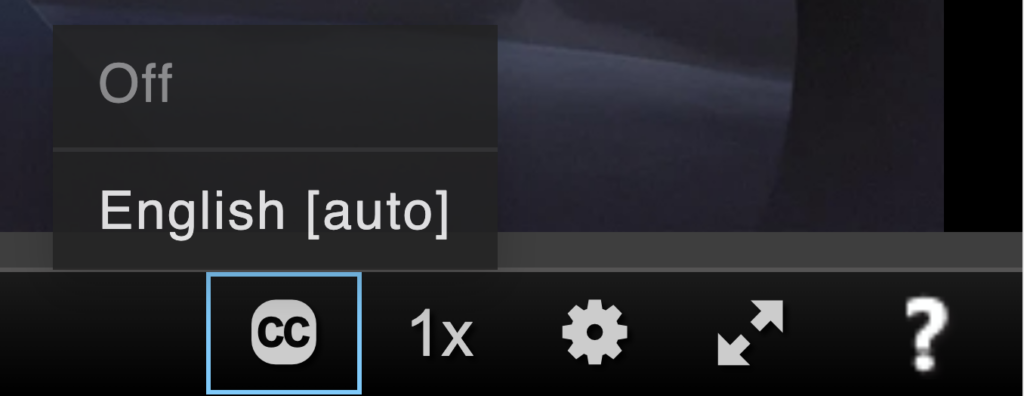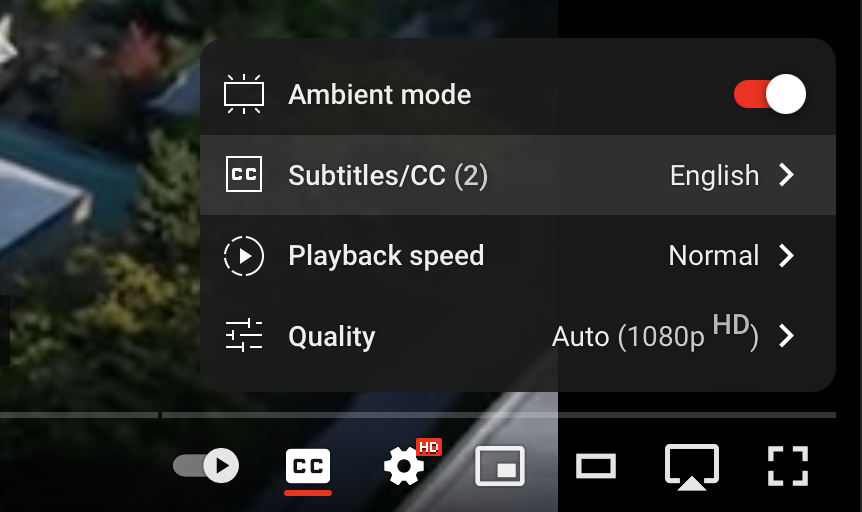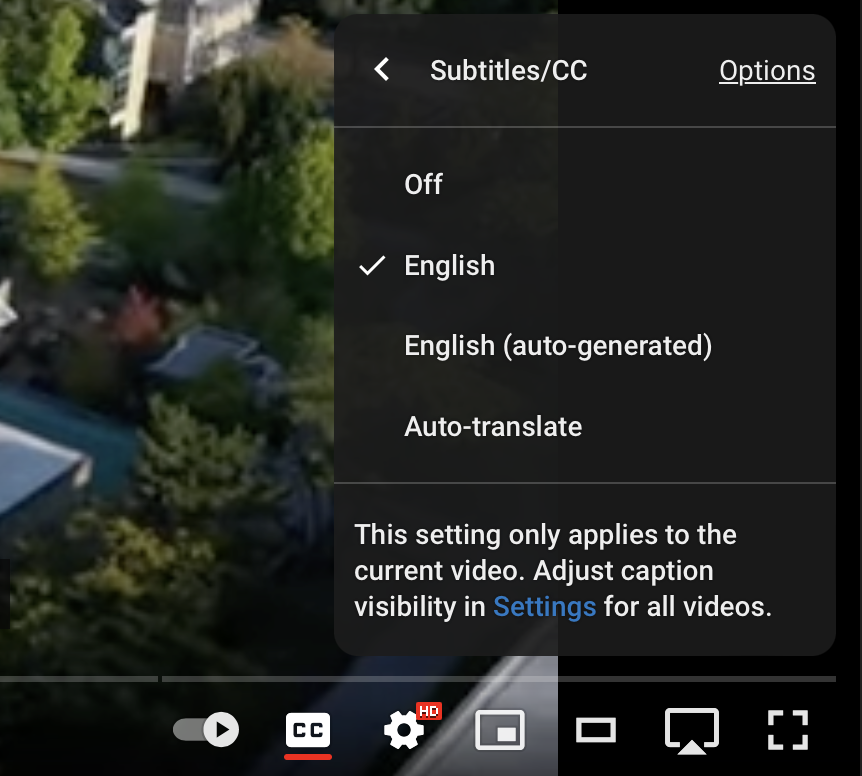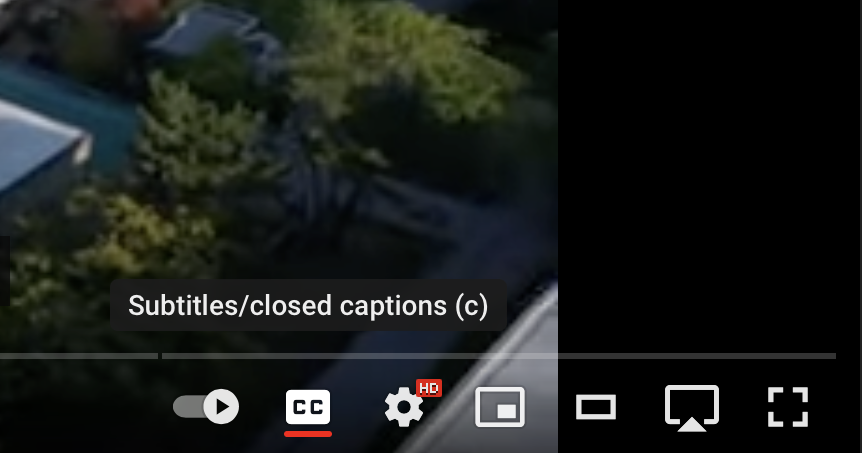Assistive Technology User Guides
Closed Captions

This page covers several ways users can enable closed captions. Ensuring videos have closed captions is the responsibility of the content owner.
On this page:
Kaltura
To display closed captions in Kaltura:
- Select the Closed Captions button.

- Choose desired language.

- Note that [auto] indicates the captions are machine-generated and may contain errors, especially in spelling of names and terminology.
YouTube
To view captions on YouTube videos:
- Click Settings.
- Select Subtitles/closed captions.

- Choose desired language.

- Choose desired language.
- Click Subtitles/closed captions on the player toolbar to toggle captions on and off.

Manage subtitle settings – YouTube Help.
Zoom
To enable captions in a meeting:
- Select Closed Caption or Live Transcript button in the toolbar.
- Under Live Transcription, select Enable.
- This will inform participants captions are available.
Participants can request the host turn on captioning. Please approve requests as each user can choose to view or hide captions when available. Best practice would be to enable them when you start a meeting before participants must request.
To save a copy of the transcript:
- Select the up arrow on the Live Transcript button and select View Full Transcript.
- Select Save Transcript.
If you are recording the meeting, the transcript will be saved to the same folder as the video. Contact Langara’s Assistive Technologist for assistance in using the transcript to create a captioned version to be distributed.
If you are not seeing the Closed Caption or Live Transcript button on the Zoom toolbar, you need to enable the option in the Zoom web portal.
- Sign in to Zoom.
- Navigate to Settings.
- Under the Meeting tab.
- Move to In Meeting (Advanced).
- Select Allow live transcription service to transcribe meeting automatically checkbox.
Teams
To view live captions in a Teams meeting:
- Select Settings and more.
- Settings.
- Captions and transcripts.
- Toggle Always show live captions in meetings on.
- When joining a meeting Teams will prompt for the spoken language. Select English (Canada) or other listed language and click Confirm.
- At the bottom of the meeting window is the captions window. Select Settings to change the language, style, font, and position of the captions.
Use live captions in Microsoft Teams meetings – Microsoft Support
Android
Live Transcribe
- Navigate to Settings > Accessibility.
- Select Installed apps (requires the Android Accessibility Suite).
- Choose Live Transcribe and toggle Live Transcribe shortcut to On.
- Tap on Accessibility shortcut.
- Select Live Transcribe.
- Follow prompts to set permissions.
- Dictate your text or use Live Transcribe to see text of conversations.
- Many default apps (Chrome, Play Store) will include a microphone icon in the search box. Use that to search using your voice.
Captions
- Navigate to Settings > Accessibility.
- Select Hearing enhancements.
- Tap Caption preference.
- Toggle Show captions to on.
- Tap Caption size and style to change appearance.
Chrome
Chrome includes an automatic captioning tool for videos. The captions are not a substitute for proper captioning of videos but may be a useful tool for users when encountering an uncaptioned video. To enable:
- Select More > Settings.
- Select Advanced > Accessibility > Captions.
- Turn on Live Captions.
Chrome live captions uses the operating system’s default captioning styling:
iOS
Subtitles & Captioning
When available, captions can be displayed:
- Navigate to Settings > Accessibility.
- Select Subtitles & Captioning.
- Toggle Closed Captions + SDH on.
- Select Style to change the appearance of captions.
Live Captions
Live Captions can transcribe audio in videos and live conversation. To use:
- Navigate to Settings > Accessibility.
- Select Live Captions (Beta) and toggle Live Captions on.
- Select Appearance to customize caption text, colour, and opacity.
- Tap the Live Captions widget (opaque soundwave icon) to activate.
- Tap the window for options including fullscreen, pause, and close.
- Tap the microphone to toggle between Live Captions (device audio) and Active Captions (real world audio picked up by your microphone).
*This feature is new to iOS 16 and may not provide captions everywhere.
Get live captions in real time on iPhone – Apple Support
Dictation
- Set up and turn on Voice Control.
- Ensure Voice Control is listening and when in an active textbox, simply start speaking.
- Or, navigate to Settings > General > Keyboard.
- Toggle Enable Dictation on.
- When the onscreen keyboard appears, tap the microphone icon in the bottom right.
macOS
Subtitles and Closed Captions
- Navigate to System Preferences > Accessibility.
- Choose Captions in the sidebar.
- Change style and options for default captions.
macOS caption settings are still dependent on the source captions. If a video is not captioned, macOS cannot create it’s own captions.
Additional information on subtitles and closed caption settings.
Live Captions
macOS may be able to provide live captions for video and live conversation:
- Open System Settings > Accessibility.
- Under Hearing, select Live Captions (Beta).
- Toggle Live Captions on.
- Use the settings to change font style and background colour.
- Click and drag the Live Captions widget anywhere on the screen.
- Click and drag from any corner to resize the widget.
- Click anywhere on the widget to reveal controls.
- Use Pause to pause captions.
- Click the microphone to toggle between Live Captions (computer audio) and Active Captions (real world audio picked up by your microphone).
Dictation
macOS has a built-in dictation feature to use speech input to write documents. To enable:
- Navigate to System Preferences.
- Select Keyboard.
- Select Dictation tab.
- Select On radio button.
To dictate text, select a text edit field (such as browser address bar or a document) and click the microphone window or navigate to Edit > Start Dictation.
Speak slowly and articulate as best you can. Use natural language for commands, such as “new line” or “exclamation point”. macOS has a complete list of dictation commands here.
Learn more about how to dictate messages and documents on Mac.
Group Transcribe
Group Transcribe is a Microsoft app for iOS only. Group Transcribe creates a digital space for in-person meetings. Each attendee opens Group Transcribe and all conversation is converted to text and displayed in a stream with speaker labels.

